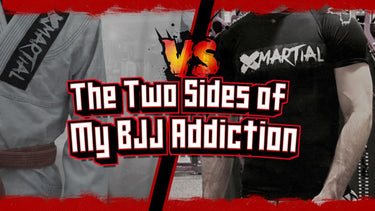
The first time I felt the burn of Gi fabric against my neck during a cross-collar choke, I knew I was hooked. Then, months later, when I experienced the slippery scramble of no Gi grappling, I realized my Brazilian Jiu Jitsu addiction had two distinct but equally captivating sides.
As a 10-year practitioner and brown belt, I've spent thousands of hours exploring both worlds. The Gi vs no Gi debate isn't about which is better—it's about understanding how each enriches your Jiu Jitsu journey.
🥋 What Is Gi BJJ?
Gi BJJ is the traditional form of Brazilian Jiu Jitsu where practitioners wear a kimono. It’s all about grip, control, and strategic movement. You can grab the collar, sleeves, pants — even your opponent’s belt — to dominate and submit.
✅ Best For:
- Building fundamentals
- IBJJF competitions
- Grip-based strategies
- Methodical development
🩳 What Is No Gi BJJ?
No Gi BJJ is the faster, more athletic version of grappling practiced in rash guards and shorts. Without clothing grips, it emphasizes clinching, body control, and reaction speed.
✅ Best For:
- MMA & self-defense crossover
- ADCC or sub-only events
- Gripless control
- Speed and transitions
⚔️ Side-by-Side Comparison
| Attribute | Gi BJJ | No Gi BJJ |
| Attire | Kimono, belt | Rash guard, shorts |
| Pace | Slower, more strategic | Fast-paced and dynami |
| Grip Strategy | Fabric grips (lapel, sleeve, pants) | Body grips, underhooks, neck |
| Submissions | Lapel chokes, bow & arrow | Leg locks, guillotines, darce |
| Common Use | Traditional BJJ, sport competition | MMA, modern grappling |
🔍 Key Technical Differences
Gi-Specific Techniques:
- Spider guard
- Collar chokes
- Lapel guards
- Sleeve & belt grips
No Gi-Focused Techniques:
- Leg locks & heel hooks
- Front headlocks & guillotines
- Body lock passes
- Wrestling takedowns
My fingers would ache from Gi grips, and every error became a lesson. In no Gi, I learned to rely on precision timing, explosive movement, and positional control.

Gi builds:
- Precision and grip endurance
- Defensive awareness
- Patience and positional control
No Gi builds:
- Athleticism and transitions
- Explosiveness
- Dynamic problem-solving
Training both makes you a more complete grappler. My no Gi improved from the grip battles in gi, and my gi game evolved through the pace and pressure of no Gi.
🧵 Essential Gear & Rule Sets
Gi Gear Checklist:
- Kimono (jacket + pants)
- Belt (shows your rank)
- Cost: $100–$250
No Gi Gear Checklist:
- Rash guard
- BJJ shorts
- Optional spats
- Cost: $30–$140
Rule Sets:
- Gi: IBJJF (more restrictive)
- No Gi: ADCC & sub-only (more dynamic)
🧪 Physical & Mental Demands
Gi demands:
- Forearm/grip endurance
- Isometric control
- Slower, calculated thinking
No Gi demands:
- Cardiovascular endurance
- Speed and reaction time
- Improvised, high-speed problem solving
Gi is chess. No Gi is speed chess. Master both, and you sharpen every aspect of your game.
🏆 Competition & Culture
- Gi comps are formal and traditional
- No gi comps are looser and faster-paced
- Both are celebrated equally in the BJJ community
I’ve stood on podiums in both styles. And at my academy, medals are medals—whether you earned them in a crisp gi or a sweaty rash guard.
📅 My Personal Balance
After ten years of training, here’s what works for me:
- 3 Gi sessions per week
- 3 no Gi sessions per week
- 1 day of rest or flow drilling
This routine keeps my game balanced, fresh, and injury-free.
🧭 Which Should You Choose?
Start with Gi if:
- You want to build solid fundamentals
- You like detailed technique
Start with no Gi if:
- You want fast progress for MMA/self-defense
- You enjoy explosive, reaction-based movement
But honestly? Try both. Give it 3–6 months each and see what resonates with your style and personality.
🎯 Final Thoughts: The Complete Grappler
The Gi vs no Gi debate misses the point. They’re not rivals — they’re complements.
Whether you're gripping cloth or skin, you're developing leverage, timing, and control. Your jiu-jitsu only benefits when you learn both sides of the art.
Train both. Get addicted. Level up.
❓ FAQ: Gi vs No Gi Questions
Is Gi or No Gi better for beginners?
Gi is great for building structure, but no gi is equally valid depending on your goals.
Do I need to train both?
No, but training both makes you more well-rounded.
Which is more practical for self-defense?
No Gi reflects real-life clothing limitations, but both develop control and awareness.
Do they require different instructions?
Yes. Each has unique techniques and pacing, so training them separately is ideal.
Which is more popular?
Gi has long been dominant, but no Gi is rapidly growing thanks to submission-only events and MMA influence.
